Antibody data
- Antibody Data
- Antigen structure
- References [32]
- Comments [0]
- Validations
- Immunocytochemistry [10]
- Immunoprecipitation [1]
- Immunohistochemistry [3]
- Other assay [10]
Submit
Validation data
Reference
Comment
Report error
- Product number
- MA3-014 - Provider product page

- Provider
- Invitrogen Antibodies
- Product name
- HSC70 Monoclonal Antibody (13D3)
- Antibody type
- Monoclonal
- Antigen
- Other
- Description
- MA3-014 detects heat shock cognate protein 70 kDa (HSC70) from human, feline, primate, rat, and mouse tissues. This antibody displays slight cross-reactivity to HSP70. MA3-014 has been successfully used in Western blot, immunohistochemistry, immunofluorescence, and immunoprecipitation procedures By Western blot, this antibody detects a 70 kDa protein representing HSC70. By 2D gel electrophoresis, MA3-014 was found to bind strongly to HSC70 and faintly to HSP70 both before and after heat shock. Immunohistochemical staining of HSC70 in mouse spermatids/spermatozoa with MA3-014 results in staining restricted to the post acrosomal region in condensing spermatids and to the midpiece in spermatozoa. The MA3-014 antigen is mouse spermatogenic cell protein.
- Reactivity
- Human, Mouse, Rat, Feline
- Host
- Mouse
- Isotype
- IgM
- Antibody clone number
- 13D3
- Vial size
- 100 μL
- Concentration
- 1 mg/mL
- Storage
- -20°C, Avoid Freeze/Thaw Cycles
Submitted references Chaperone-Mediated Autophagy Markers LAMP2A and HSPA8 in Advanced Non-Small Cell Lung Cancer after Neoadjuvant Therapy.
Chaperone-Mediated Autophagy Markers LAMP2A and HSC70 Are Independent Adverse Prognostic Markers in Primary Resected Squamous Cell Carcinomas of the Lung.
Differentiation Drives Widespread Rewiring of the Neural Stem Cell Chaperone Network.
Zika Virus Dependence on Host Hsp70 Provides a Protective Strategy against Infection and Disease.
Chikungunya Virus Interacts with Heat Shock Cognate 70 Protein to Facilitate Its Entry into Mosquito Cell Line.
Parkinson Sac Domain Mutation in Synaptojanin 1 Impairs Clathrin Uncoating at Synapses and Triggers Dystrophic Changes in Dopaminergic Axons.
Two new isoforms of the human hepatoma-derived growth factor interact with components of the cytoskeleton.
Proteomic analysis of exosomes derived from human lymphoma cells.
Expression and induction of small heat shock proteins in rat heart under chronic hyperglycemic conditions.
Response of small heat shock proteins in diabetic rat retina.
Loss of nuclear pro-IL-16 facilitates cell cycle progression in human cutaneous T cell lymphoma.
Dissecting the role of integrin subunits alpha 2 and beta 3 in rotavirus cell entry by RNA silencing.
Heat shock enhances the susceptibility of BHK cells to rotavirus infection through the facilitation of entry and post-entry virus replication steps.
Beta-amyloid treatment of two complementary P301L tau-expressing Alzheimer's disease models reveals similar deregulated cellular processes.
Proteomic analysis of exosomes secreted by human mesothelioma cells.
The repeated bout effect and heat shock proteins: intramuscular HSP27 and HSP70 expression following two bouts of eccentric exercise in humans.
Heat shock cognate protein 70 is involved in rotavirus cell entry.
Heat shock cognate protein 70 is involved in rotavirus cell entry.
Characterization and regulation of the major histocompatibility complex-encoded proteins Hsp70-Hom and Hsp70-1/2.
Characterization and regulation of the major histocompatibility complex-encoded proteins Hsp70-Hom and Hsp70-1/2.
Heat shock cognate-70 gene expression declines during normal aging of the primate retina.
Blocking the endogenous increase in HSP 72 increases susceptibility to hypoxia and reoxygenation in isolated adult feline cardiocytes.
Blocking the endogenous increase in HSP 72 increases susceptibility to hypoxia and reoxygenation in isolated adult feline cardiocytes.
A 16-kDa protein functions as a new regulatory protein for Hsc70 molecular chaperone and is identified as a member of the Nm23/nucleoside diphosphate kinase family.
A 16-kDa protein functions as a new regulatory protein for Hsc70 molecular chaperone and is identified as a member of the Nm23/nucleoside diphosphate kinase family.
Platelet adhesion to collagen under flow causes dissociation of a phosphoprotein complex of heat-shock proteins and protein phosphatase 1.
Heat shock factor-1 and the heat shock cognate 70 protein associate in high molecular weight complexes in the cytoplasm of NIH-3T3 cells.
Protein and peptide binding and stimulation of in vitro lysosomal proteolysis by the 73-kDa heat shock cognate protein.
Heat-shock cognate protein (hsc71) and related proteins in mouse spermatogenic cells.
A novel hsp70-like protein (P70) is present in mouse spermatogenic cells.
A novel hsp70-like protein (P70) is present in mouse spermatogenic cells.
A novel hsp70-like protein (P70) is present in mouse spermatogenic cells.
Losmanova T, Zens P, Scherz A, Schmid RA, Tschan MP, Berezowska S
Cells 2021 Oct 13;10(10)
Cells 2021 Oct 13;10(10)
Chaperone-Mediated Autophagy Markers LAMP2A and HSC70 Are Independent Adverse Prognostic Markers in Primary Resected Squamous Cell Carcinomas of the Lung.
Losmanová T, Janser FA, Humbert M, Tokarchuk I, Schläfli AM, Neppl C, Schmid RA, Tschan MP, Langer R, Berezowska S
Oxidative medicine and cellular longevity 2020;2020:8506572
Oxidative medicine and cellular longevity 2020;2020:8506572
Differentiation Drives Widespread Rewiring of the Neural Stem Cell Chaperone Network.
Vonk WIM, Rainbolt TK, Dolan PT, Webb AE, Brunet A, Frydman J
Molecular cell 2020 Apr 16;78(2):329-345.e9
Molecular cell 2020 Apr 16;78(2):329-345.e9
Zika Virus Dependence on Host Hsp70 Provides a Protective Strategy against Infection and Disease.
Taguwa S, Yeh MT, Rainbolt TK, Nayak A, Shao H, Gestwicki JE, Andino R, Frydman J
Cell reports 2019 Jan 22;26(4):906-920.e3
Cell reports 2019 Jan 22;26(4):906-920.e3
Chikungunya Virus Interacts with Heat Shock Cognate 70 Protein to Facilitate Its Entry into Mosquito Cell Line.
Ghosh A, Desai A, Ravi V, Narayanappa G, Tyagi BK
Intervirology 2017;60(6):247-262
Intervirology 2017;60(6):247-262
Parkinson Sac Domain Mutation in Synaptojanin 1 Impairs Clathrin Uncoating at Synapses and Triggers Dystrophic Changes in Dopaminergic Axons.
Cao M, Wu Y, Ashrafi G, McCartney AJ, Wheeler H, Bushong EA, Boassa D, Ellisman MH, Ryan TA, De Camilli P
Neuron 2017 Feb 22;93(4):882-896.e5
Neuron 2017 Feb 22;93(4):882-896.e5
Two new isoforms of the human hepatoma-derived growth factor interact with components of the cytoskeleton.
Nüße J, Mirastschijski U, Waespy M, Oetjen J, Brandes N, Rebello O, Paroni F, Kelm S, Dietz F
Biological chemistry 2016 May;397(5):417-36
Biological chemistry 2016 May;397(5):417-36
Proteomic analysis of exosomes derived from human lymphoma cells.
Yao Y, Wei W, Sun J, Chen L, Deng X, Ma L, Hao S
European journal of medical research 2015 Jan 29;20(1):8
European journal of medical research 2015 Jan 29;20(1):8
Expression and induction of small heat shock proteins in rat heart under chronic hyperglycemic conditions.
Reddy VS, Kumar ChU, Raghu G, Reddy GB
Archives of biochemistry and biophysics 2014 Sep 15;558:1-9
Archives of biochemistry and biophysics 2014 Sep 15;558:1-9
Response of small heat shock proteins in diabetic rat retina.
Reddy VS, Raghu G, Reddy SS, Pasupulati AK, Suryanarayana P, Reddy GB
Investigative ophthalmology & visual science 2013 Nov 19;54(12):7674-82
Investigative ophthalmology & visual science 2013 Nov 19;54(12):7674-82
Loss of nuclear pro-IL-16 facilitates cell cycle progression in human cutaneous T cell lymphoma.
Curiel-Lewandrowski C, Yamasaki H, Si CP, Jin X, Zhang Y, Richmond J, Tuzova M, Wilson K, Sullivan B, Jones D, Ryzhenko N, Little F, Kupper TS, Center DM, Cruikshank WW
The Journal of clinical investigation 2011 Dec;121(12):4838-49
The Journal of clinical investigation 2011 Dec;121(12):4838-49
Dissecting the role of integrin subunits alpha 2 and beta 3 in rotavirus cell entry by RNA silencing.
Isa P, Sánchez-Alemán MA, López S, Arias CF
Virus research 2009 Nov;145(2):251-9
Virus research 2009 Nov;145(2):251-9
Heat shock enhances the susceptibility of BHK cells to rotavirus infection through the facilitation of entry and post-entry virus replication steps.
López T, López S, Arias CF
Virus research 2006 Oct;121(1):74-83
Virus research 2006 Oct;121(1):74-83
Beta-amyloid treatment of two complementary P301L tau-expressing Alzheimer's disease models reveals similar deregulated cellular processes.
David DC, Ittner LM, Gehrig P, Nergenau D, Shepherd C, Halliday G, Götz J
Proteomics 2006 Dec;6(24):6566-77
Proteomics 2006 Dec;6(24):6566-77
Proteomic analysis of exosomes secreted by human mesothelioma cells.
Hegmans JP, Bard MP, Hemmes A, Luider TM, Kleijmeer MJ, Prins JB, Zitvogel L, Burgers SA, Hoogsteden HC, Lambrecht BN
The American journal of pathology 2004 May;164(5):1807-15
The American journal of pathology 2004 May;164(5):1807-15
The repeated bout effect and heat shock proteins: intramuscular HSP27 and HSP70 expression following two bouts of eccentric exercise in humans.
Thompson HS, Clarkson PM, Scordilis SP
Acta physiologica Scandinavica 2002 Jan;174(1):47-56
Acta physiologica Scandinavica 2002 Jan;174(1):47-56
Heat shock cognate protein 70 is involved in rotavirus cell entry.
Guerrero CA, Bouyssounade D, Zárate S, Isa P, López T, Espinosa R, Romero P, Méndez E, López S, Arias CF
Journal of virology 2002 Apr;76(8):4096-102
Journal of virology 2002 Apr;76(8):4096-102
Heat shock cognate protein 70 is involved in rotavirus cell entry.
Guerrero CA, Bouyssounade D, Zárate S, Isa P, López T, Espinosa R, Romero P, Méndez E, López S, Arias CF
Journal of virology 2002 Apr;76(8):4096-102
Journal of virology 2002 Apr;76(8):4096-102
Characterization and regulation of the major histocompatibility complex-encoded proteins Hsp70-Hom and Hsp70-1/2.
Fourie AM, Peterson PA, Yang Y
Cell stress & chaperones 2001 Jul;6(3):282-95
Cell stress & chaperones 2001 Jul;6(3):282-95
Characterization and regulation of the major histocompatibility complex-encoded proteins Hsp70-Hom and Hsp70-1/2.
Fourie AM, Peterson PA, Yang Y
Cell stress & chaperones 2001 Jul;6(3):282-95
Cell stress & chaperones 2001 Jul;6(3):282-95
Heat shock cognate-70 gene expression declines during normal aging of the primate retina.
Bernstein SL, Liu AM, Hansen BC, Somiari RI
Investigative ophthalmology & visual science 2000 Sep;41(10):2857-62
Investigative ophthalmology & visual science 2000 Sep;41(10):2857-62
Blocking the endogenous increase in HSP 72 increases susceptibility to hypoxia and reoxygenation in isolated adult feline cardiocytes.
Nakano M, Mann DL, Knowlton AA
Circulation 1997 Mar 18;95(6):1523-31
Circulation 1997 Mar 18;95(6):1523-31
Blocking the endogenous increase in HSP 72 increases susceptibility to hypoxia and reoxygenation in isolated adult feline cardiocytes.
Nakano M, Mann DL, Knowlton AA
Circulation 1997 Mar 18;95(6):1523-31
Circulation 1997 Mar 18;95(6):1523-31
A 16-kDa protein functions as a new regulatory protein for Hsc70 molecular chaperone and is identified as a member of the Nm23/nucleoside diphosphate kinase family.
Leung SM, Hightower LE
The Journal of biological chemistry 1997 Jan 31;272(5):2607-14
The Journal of biological chemistry 1997 Jan 31;272(5):2607-14
A 16-kDa protein functions as a new regulatory protein for Hsc70 molecular chaperone and is identified as a member of the Nm23/nucleoside diphosphate kinase family.
Leung SM, Hightower LE
The Journal of biological chemistry 1997 Jan 31;272(5):2607-14
The Journal of biological chemistry 1997 Jan 31;272(5):2607-14
Platelet adhesion to collagen under flow causes dissociation of a phosphoprotein complex of heat-shock proteins and protein phosphatase 1.
Polanowska-Grabowska R, Simon CG Jr, Falchetto R, Shabanowitz J, Hunt DF, Gear AR
Blood 1997 Aug 15;90(4):1516-26
Blood 1997 Aug 15;90(4):1516-26
Heat shock factor-1 and the heat shock cognate 70 protein associate in high molecular weight complexes in the cytoplasm of NIH-3T3 cells.
Nunes SL, Calderwood SK
Biochemical and biophysical research communications 1995 Aug 4;213(1):1-6
Biochemical and biophysical research communications 1995 Aug 4;213(1):1-6
Protein and peptide binding and stimulation of in vitro lysosomal proteolysis by the 73-kDa heat shock cognate protein.
Terlecky SR, Chiang HL, Olson TS, Dice JF
The Journal of biological chemistry 1992 May 5;267(13):9202-9
The Journal of biological chemistry 1992 May 5;267(13):9202-9
Heat-shock cognate protein (hsc71) and related proteins in mouse spermatogenic cells.
Maekawa M, O'Brien DA, Allen RL, Eddy EM
Biology of reproduction 1989 Apr;40(4):843-52
Biology of reproduction 1989 Apr;40(4):843-52
A novel hsp70-like protein (P70) is present in mouse spermatogenic cells.
Allen RL, O'Brien DA, Eddy EM
Molecular and cellular biology 1988 Feb;8(2):828-32
Molecular and cellular biology 1988 Feb;8(2):828-32
A novel hsp70-like protein (P70) is present in mouse spermatogenic cells.
Allen RL, O'Brien DA, Eddy EM
Molecular and cellular biology 1988 Feb;8(2):828-32
Molecular and cellular biology 1988 Feb;8(2):828-32
A novel hsp70-like protein (P70) is present in mouse spermatogenic cells.
Allen RL, O'Brien DA, Eddy EM
Molecular and cellular biology 1988 Feb;8(2):828-32
Molecular and cellular biology 1988 Feb;8(2):828-32
No comments: Submit comment
Supportive validation
- Submitted by
- Invitrogen Antibodies (provider)
- Main image
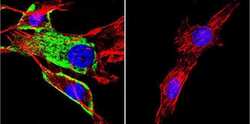
- Experimental details
- Immunofluorescent analysis of HSC70 using Monoclonal antibody (13D3) (Product # MA3-014) shows staining in NIH-3T3 cells. HSC70 staining (green), F-Actin staining with Phalloidin (red) and nuclei with DAPI (blue) is shown. Cells were grown on chamber slides and fixed with formaldehyde prior to staining. Cells were probed without (control) or with or an antibody recognizing HSC70 (Product # MA3-014) at a dilution of 1:20-1:200 over night at 4 °C, washed with PBS and incubated with a DyLight-488 conjugated secondary antibody (Product # 35552 for GAR, Product # 35503 for GAM). Images were taken at 60X magnification.
- Submitted by
- Invitrogen Antibodies (provider)
- Main image
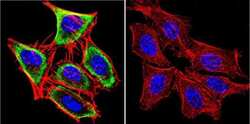
- Experimental details
- Immunofluorescent analysis of HSC70 using HSC70 Monoclonal antibody (13D3) (Product # MA3-014) shows staining in HeLa cells. HSC70 staining (green), F-Actin staining with Phalloidin (red) and nuclei with DAPI (blue) is shown. Cells were grown on chamber slides and fixed with formaldehyde prior to staining. Cells were probed without (control) or with or an antibody recognizing HSC70 (Product # MA3-014) at a dilution of 1:20-1:200 over night at 4 °C, washed with PBS and incubated with a DyLight-488 conjugated secondary antibody (Product # 35552 for GAR, Product # 35503 for GAM). Images were taken at 60X magnification.
- Submitted by
- Invitrogen Antibodies (provider)
- Main image
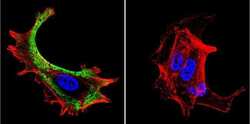
- Experimental details
- Immunofluorescent analysis of HSC70 using HSC70 Monoclonal antibody (13D3) (Product # MA3-014) shows staining in MCF-7 cells. HSC70 staining (green), F-Actin staining with Phalloidin (red) and nuclei with DAPI (blue) is shown. Cells were grown on chamber slides and fixed with formaldehyde prior to staining. Cells were probed without (control) or with or an antibody recognizing HSC70 (Product # MA3-014) at a dilution of 1:20-1:200 °C, washed with PBS and incubated with a DyLight-488 conjugated secondary antibody (Product # 35552 for GAR, Product # 35503 for GAM). Images were taken at 60X magnification.
- Submitted by
- Invitrogen Antibodies (provider)
- Main image
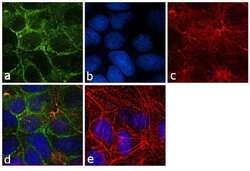
- Experimental details
- Immunofluorescence analysis of HSC70/Heat Shock Cognate Protein was performed using 70% confluent log phase Caco-2 cells. The cells were fixed with 4% paraformaldehyde for 10 minutes, permeabilized with 0.1% Triton™ X-100 for 10 minutes, and blocked with 1% BSA for 1 hour at room temperature. The cells were labeled with HSC70/Heat Shock Cognate Protein Mouse Monoclonal Antibody (Product # MA3-014) at 1:250 dilution in 0.1% BSA and incubated for 3 hours at room temperature and then labeled with Goat anti-Mouse IgG (H+L)/IgM (L) Superclonal™ Secondary Antibody, Alexa Fluor® 488 conjugate (Product # A28175) at a dilution of 1:2000 for 45 minutes at room temperature (Panel a: green). Nuclei (Panel b: blue) were stained with SlowFade® Gold Antifade Mountant with DAPI (Product # S36938). F-actin (Panel c: red) was stained with Rhodamine Phalloidin (Product # R415, 1:300). Panel d represents the merged image showing cytoplasmic and membranous localization. Panel e shows the no primary antibody control. The images were captured at 60X magnification.
- Submitted by
- Invitrogen Antibodies (provider)
- Main image
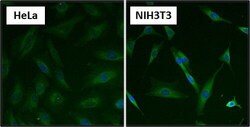
- Experimental details
- Immunofluorescent analysis of Heat Shock Protein 70 (HSC70) (green) in HeLa and NIH3T3 cells. Formalin fixed cells were permeabilized with 0.1% Triton X-100 in TBS for 10 minutes at room temperature and blocked with 1% Blocker BSA (Product # 37525) for 15 minutes at room temperature. Cells were probed with a HSC70 monoclonal antibody (Product # MA3-014) at a dilution of 1:50 for at least 1 hour at room temperature, washed with PBS, and incubated with DyLight 488 goat anti-mouse IgG secondary antibody (Product # 35502) at a dilution of 1:400 for 30 minutes at room temperature. Nuclei (blue) were stained with Hoechst 33342 dye (Product # 62249). Images were taken on a Thermo Scientific ArrayScan at 20X magnification.
- Submitted by
- Invitrogen Antibodies (provider)
- Main image
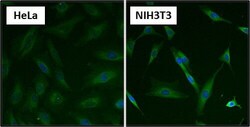
- Experimental details
- Immunofluorescent analysis of Heat Shock Protein 70 (HSC70) (green) in HeLa and NIH3T3 cells. Formalin fixed cells were permeabilized with 0.1% Triton X-100 in TBS for 10 minutes at room temperature and blocked with 1% Blocker BSA (Product # 37525) for 15 minutes at room temperature. Cells were probed with a HSC70 monoclonal antibody (Product # MA3-014) at a dilution of 1:50 for at least 1 hour at room temperature, washed with PBS, and incubated with DyLight 488 goat anti-mouse IgG secondary antibody (Product # 35502) at a dilution of 1:400 for 30 minutes at room temperature. Nuclei (blue) were stained with Hoechst 33342 dye (Product # 62249). Images were taken on a Thermo Scientific ArrayScan at 20X magnification.
- Submitted by
- Invitrogen Antibodies (provider)
- Main image
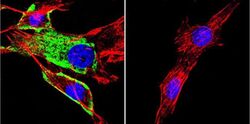
- Experimental details
- Immunofluorescent analysis of HSC70 using Monoclonal antibody (13D3) (Product # MA3-014) shows staining in NIH-3T3 cells. HSC70 staining (green), F-Actin staining with Phalloidin (red) and nuclei with DAPI (blue) is shown. Cells were grown on chamber slides and fixed with formaldehyde prior to staining. Cells were probed without (control) or with or an antibody recognizing HSC70 (Product # MA3-014) at a dilution of 1:20-1:200 over night at 4 °C, washed with PBS and incubated with a DyLight-488 conjugated secondary antibody (Product # 35552 for GAR, Product # 35503 for GAM). Images were taken at 60X magnification.
- Submitted by
- Invitrogen Antibodies (provider)
- Main image
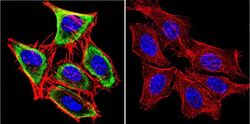
- Experimental details
- Immunofluorescent analysis of HSC70 using HSC70 Monoclonal antibody (13D3) (Product # MA3-014) shows staining in HeLa cells. HSC70 staining (green), F-Actin staining with Phalloidin (red) and nuclei with DAPI (blue) is shown. Cells were grown on chamber slides and fixed with formaldehyde prior to staining. Cells were probed without (control) or with or an antibody recognizing HSC70 (Product # MA3-014) at a dilution of 1:20-1:200 over night at 4 °C, washed with PBS and incubated with a DyLight-488 conjugated secondary antibody (Product # 35552 for GAR, Product # 35503 for GAM). Images were taken at 60X magnification.
- Submitted by
- Invitrogen Antibodies (provider)
- Main image
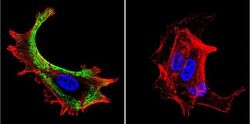
- Experimental details
- Immunofluorescent analysis of HSC70 using HSC70 Monoclonal antibody (13D3) (Product # MA3-014) shows staining in MCF-7 cells. HSC70 staining (green), F-Actin staining with Phalloidin (red) and nuclei with DAPI (blue) is shown. Cells were grown on chamber slides and fixed with formaldehyde prior to staining. Cells were probed without (control) or with or an antibody recognizing HSC70 (Product # MA3-014) at a dilution of 1:20-1:200 °C, washed with PBS and incubated with a DyLight-488 conjugated secondary antibody (Product # 35552 for GAR, Product # 35503 for GAM). Images were taken at 60X magnification.
- Submitted by
- Invitrogen Antibodies (provider)
- Main image
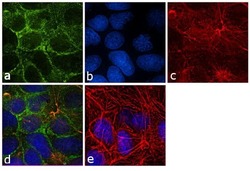
- Experimental details
- Immunofluorescence analysis of HSC70/Heat Shock Cognate Protein was performed using 70% confluent log phase Caco-2 cells. The cells were fixed with 4% paraformaldehyde for 10 minutes, permeabilized with 0.1% Triton™ X-100 for 10 minutes, and blocked with 1% BSA for 1 hour at room temperature. The cells were labeled with HSC70/Heat Shock Cognate Protein Mouse Monoclonal Antibody (Product # MA3-014) at 1:250 dilution in 0.1% BSA and incubated for 3 hours at room temperature and then labeled with Goat anti-Mouse IgG (H+L)/IgM (L) Superclonal™ Secondary Antibody, Alexa Fluor® 488 conjugate (Product # A28175) at a dilution of 1:2000 for 45 minutes at room temperature (Panel a: green). Nuclei (Panel b: blue) were stained with SlowFade® Gold Antifade Mountant with DAPI (Product # S36938). F-actin (Panel c: red) was stained with Rhodamine Phalloidin (Product # R415, 1:300). Panel d represents the merged image showing cytoplasmic and membranous localization. Panel e shows the no primary antibody control. The images were captured at 60X magnification.
Supportive validation
- Submitted by
- Invitrogen Antibodies (provider)
- Main image
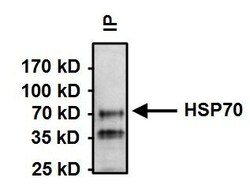
- Experimental details
- Immunoprecipitation of HSC70 was performed on HeLa cells. Antigen-antibody complexes were formed by incubating 500 µg whole cell lysate with 2 µL of HSC70 monoclonal antibody (Product # MA3-014) overnight on a rocking platform at 4°C. The immune complexes were captured on 50 µL Protein A/G Plus Agarose (Product # 20421), washed extensively, and eluted with Lane Marker Reducing Sample Buffer (Product # 39000). Samples were resolved on a 4-20% Tris-HCl polyacrylamide gel, transferred to a PVDF membrane, and blocked with 5% BSA/TBST for at least 1 hour. The membrane was probed with a HSC70 monoclonal antibody (Product # MA3-014) at a dilution of 1:1000 overnight rotating at 4°C, washed in TBST, and probed with goat anti-mouse IgM-HRP secondary antibody (Product # 31440) for at least 1 hour. Chemiluminescent detection was performed using SuperSignal West Dura (Product # 34075).
Supportive validation
- Submitted by
- Invitrogen Antibodies (provider)
- Main image
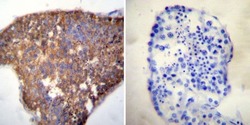
- Experimental details
- Immunohistochemistry was performed on normal deparaffinized human Testis tissue. To expose target proteins, heat induced antigen retrieval was performed using 10mM sodium citrate (pH6.0) buffer, microwaved for 8-15 minutes. Following antigen retrieval tissues were blocked in 3% BSA-PBS for 30 minutes at room temperature. Tissues were then probed at a dilution of 1:20 with a mouse monoclonal antibody recognizing Heat Shock Cognate Protein 70 (Product # MA3-014) or without primary antibody (negative control) overnight at 4°C in a humidified chamber. Tissues were washed extensively with PBST and endogenous peroxidase activity was quenched with a peroxidase suppressor. Detection was performed using a biotin-conjugated secondary antibody and SA-HRP, followed by colorimetric detection using DAB. Tissues were counterstained with hematoxylin and prepped for mounting.
- Submitted by
- Invitrogen Antibodies (provider)
- Main image
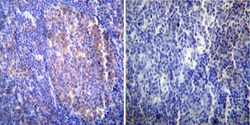
- Experimental details
- Immunohistochemistry was performed on normal deparaffinized human Tonsil tissue. To expose target proteins, heat induced antigen retrieval was performed using 10mM sodium citrate (pH6.0) buffer, microwaved for 8-15 minutes. Following antigen retrieval tissues were blocked in 3% BSA-PBS for 30 minutes at room temperature. Tissues were then probed at a dilution of 1:20 with a mouse monoclonal antibody recognizing Heat Shock Cognate Protein 70 (Product # MA3-014) or without primary antibody (negative control) overnight at 4°C in a humidified chamber. Tissues were washed extensively with PBST and endogenous peroxidase activity was quenched with a peroxidase suppressor. Detection was performed using a biotin-conjugated secondary antibody and SA-HRP, followed by colorimetric detection using DAB. Tissues were counterstained with hematoxylin and prepped for mounting.
- Submitted by
- Invitrogen Antibodies (provider)
- Main image
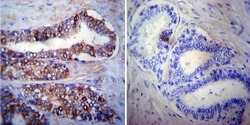
- Experimental details
- Immunohistochemistry was performed on cancer biopsies of deparaffinized human Prostate carcinoma tissue. To expose target proteins, heat induced antigen retrieval was performed using 10mM sodium citrate (pH6.0) buffer, microwaved for 8-15 minutes. Following antigen retrieval tissues were blocked in 3% BSA-PBS for 30 minutes at room temperature. Tissues were then probed at a dilution of 1:200 with a mouse monoclonal antibody recognizing Heat Shock Cognate Protein 70 (Product # MA3-014) or without primary antibody (negative control) overnight at 4°C in a humidified chamber. Tissues were washed extensively with PBST and endogenous peroxidase activity was quenched with a peroxidase suppressor. Detection was performed using a biotin-conjugated secondary antibody and SA-HRP, followed by colorimetric detection using DAB. Tissues were counterstained with hematoxylin and prepped for mounting.
Supportive validation
- Submitted by
- Invitrogen Antibodies (provider)
- Main image

- Experimental details
- NULL
- Submitted by
- Invitrogen Antibodies (provider)
- Main image
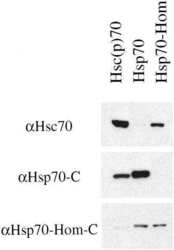
- Experimental details
- NULL
- Submitted by
- Invitrogen Antibodies (provider)
- Main image
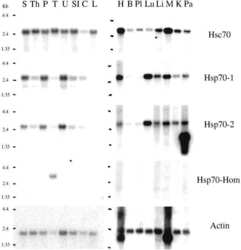
- Experimental details
- NULL
- Submitted by
- Invitrogen Antibodies (provider)
- Main image
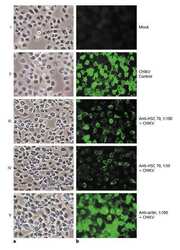
- Experimental details
- NULL
- Submitted by
- Invitrogen Antibodies (provider)
- Main image
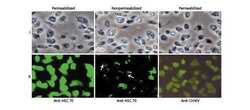
- Experimental details
- NULL
- Submitted by
- Invitrogen Antibodies (provider)
- Main image
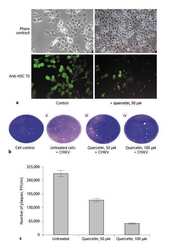
- Experimental details
- NULL
- Submitted by
- Invitrogen Antibodies (provider)
- Main image
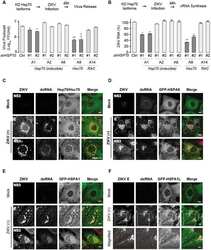
- Experimental details
- NULL
- Submitted by
- Invitrogen Antibodies (provider)
- Main image

- Experimental details
- Immunoprecipitation of HSC70 was performed on HeLa cells. Antigen-antibody complexes were formed by incubating 500 µg whole cell lysate with 2 µL of HSC70 monoclonal antibody (Product # MA3-014) overnight on a rocking platform at 4°C. The immune complexes were captured on 50 µL Protein A/G Plus Agarose (Product # 20421), washed extensively, and eluted with Lane Marker Reducing Sample Buffer (Product # 39000). Samples were resolved on a 4-20% Tris-HCl polyacrylamide gel, transferred to a PVDF membrane, and blocked with 5% BSA/TBST for at least 1 hour. The membrane was probed with a HSC70 monoclonal antibody (Product # MA3-014) at a dilution of 1:1000 overnight rotating at 4°C, washed in TBST, and probed with goat anti-mouse IgM-HRP secondary antibody (Product # 31440) for at least 1 hour. Chemiluminescent detection was performed using SuperSignal West Dura (Product # 34075).
- Submitted by
- Invitrogen Antibodies (provider)
- Main image
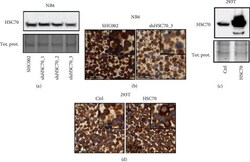
- Experimental details
- Figure 2 Validation of HSC70 immunohistochemical staining. (a, b) HSC70 knockdown in NB4 APL cells. (a) HSC70 knockdown efficiency of three independent shRNAs (shHSC70_1-3) was determined by western blotting and comparison to scramble shRNA transduced control cells (SHC002). (b) The most efficient HSC70 knockdown (shHSC70_3) was selected and subjected to immunohistochemistry. (c, d) 293 T cells were transiently transfected with an empty vector (ctrl) and HSC70 expression plasmid. (c) HSC70 expression was validated by western blotting. (d) 293 T cells were subjected to HSC70 immunohistochemistry.
- Submitted by
- Invitrogen Antibodies (provider)
- Main image
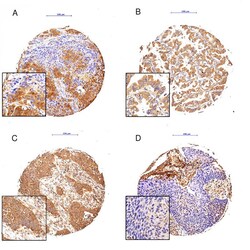
- Experimental details
- Figure 3 HSPA8, examples of immunohistochemical staining: ( A ): Adenocarcinoma, IRS 3 x 3 = 9; ( B ) Adenocarcinoma, IRS 2 x 4 = 8; ( C ): Squamous cell carcinoma, IRS 2 x 4 = 8; ( D ): Squamous cell carcinoma, IRS 0 x 4 = 0; Objective magnification: 10x, Scale bar: 200 um.
 Explore
Explore Validate
Validate Learn
Learn Western blot
Western blot Immunocytochemistry
Immunocytochemistry